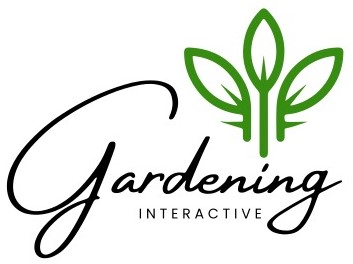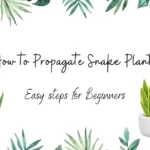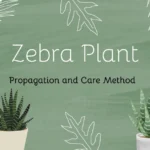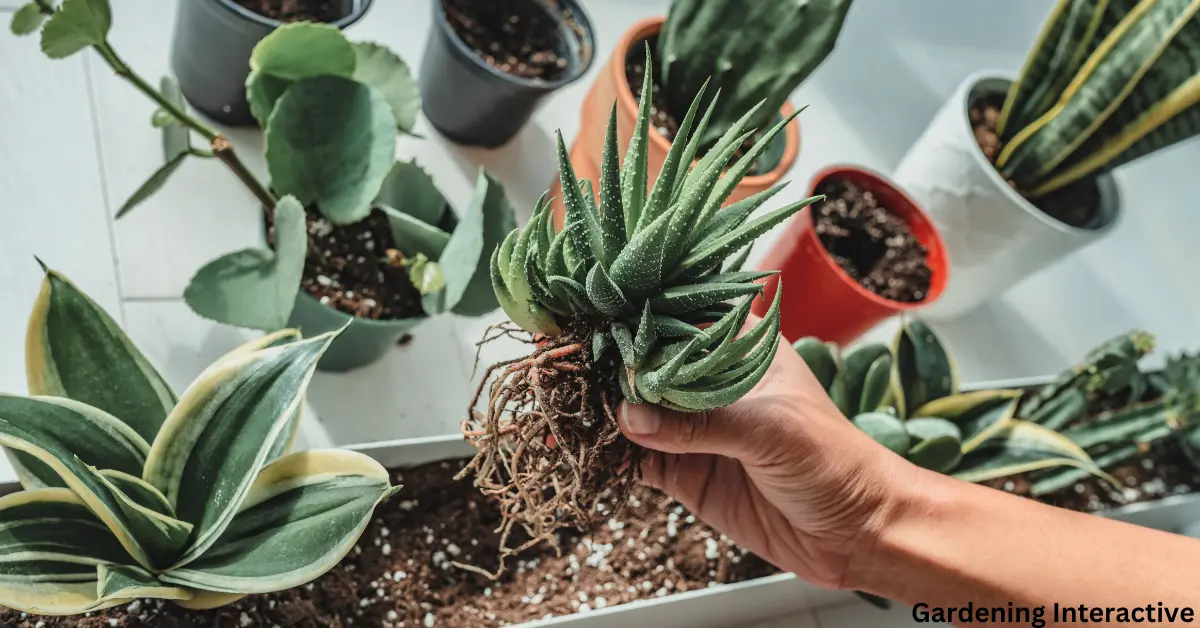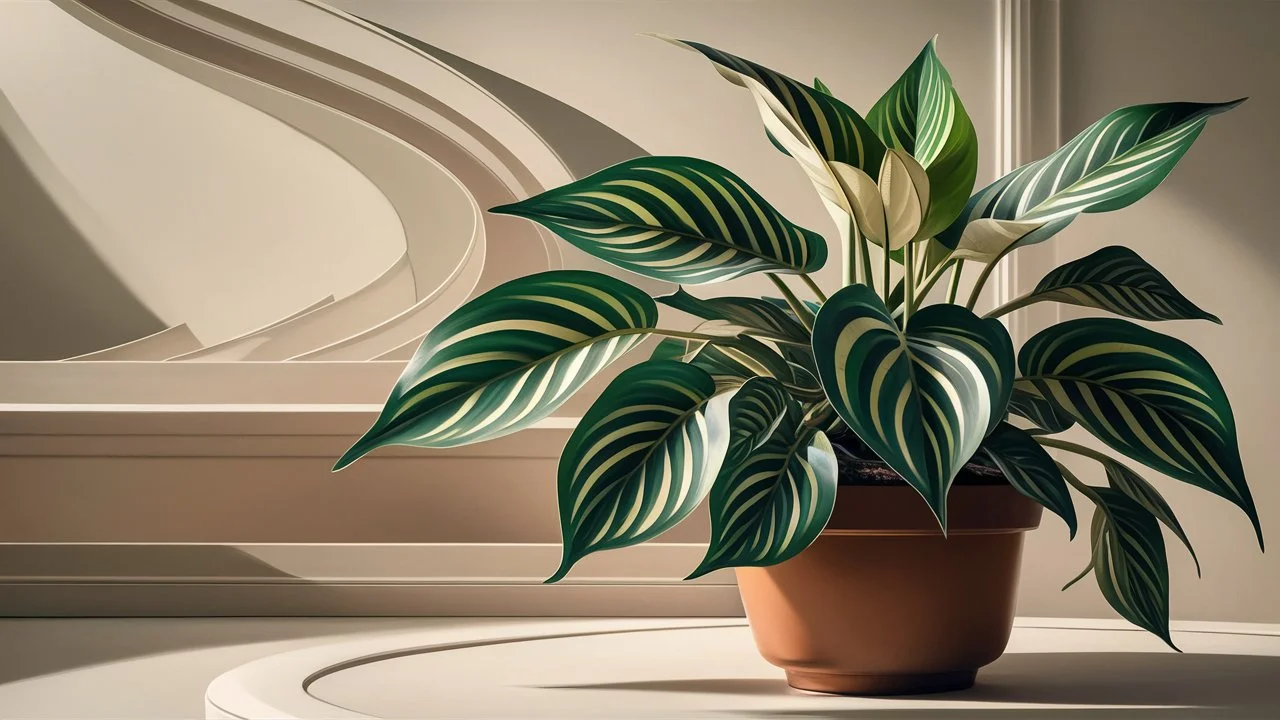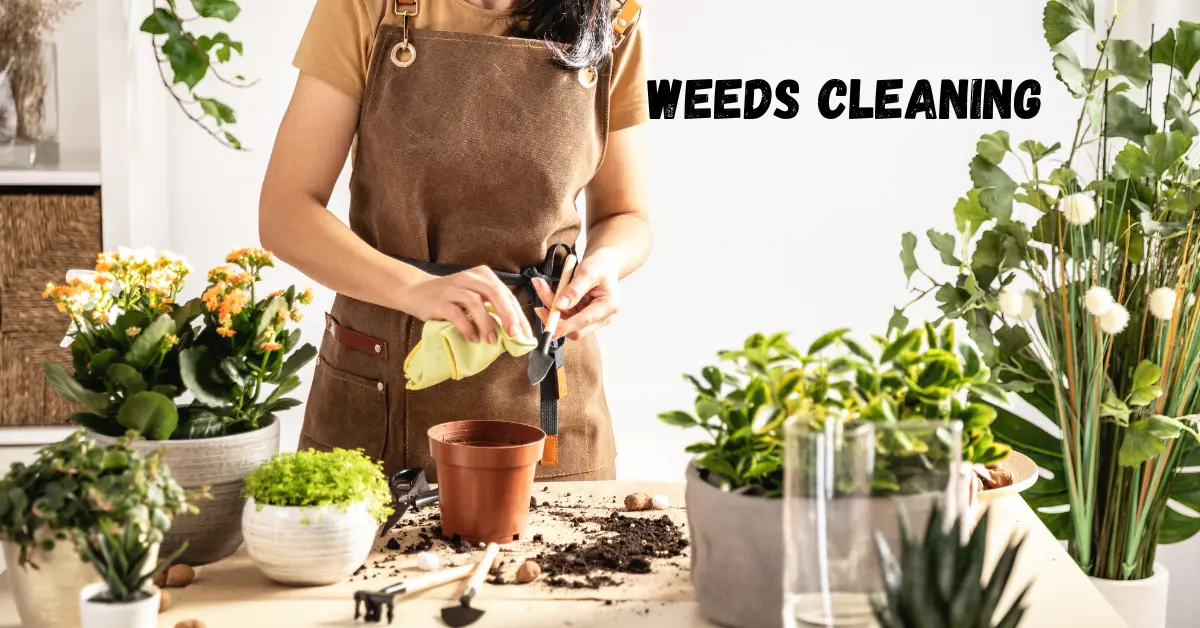
15 Big Leaf Indoor Plants
- Mitford Rakib
- March 22, 2024
- Plants
- 0 Comments
Table of Contents
ToggleAn in depth detailed information about 15 Big Leaf Indoor Plants
Introduction:
Indoor gardening lover, get ready to impress yourself in the huge world of big leaf plants! These botanical wonders not only beautify your living space but also bring the joyful essence of nature indoors. Join us as we delve into the intricacies of 15 captivating big leaf indoor plants, discovering the unique characteristics that make each one a green gem.
1. Fiddle Leaf Fig (Ficus Iyrata):
The fiddle leaf fig, perhaps the most well-liked indoor tree, grows quickly and is known for its broad, glossy leaves. These trees are regarded as natural air purifiers since they help in the removal of dangerous poisons and other particles from the air. Just remember that this plant needs room to breathe in its roots, so when you see limited development, make sure that you relocate it.
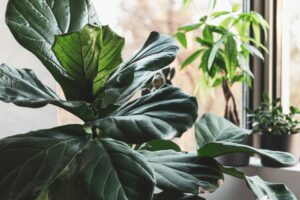
- Species: Ficus Iyrata
- Colors: Large, violin-shaped leaves in a rich shade of green
- Season: Flourishes year-round
- Growth: Grows tall and upright, creating an impressive focal point
- Soil Composition: Prefers a well-draining potting mix
- Care: Indirect sunlight, regular watering, and occasional misting for optimal health.
2. Monsteras (Monstera deliciosa):
One of the most common houseplants for good reason is the monstera, often known as the Swiss cheese plant, which is attractive to the eye and has little maintenance. This plant is ideal for filling an empty spot because it not only rapidly grows but also purifies the air around it. As the plant ages, its glossy, heart-shaped leaves will separate from the leaf margin to the center.
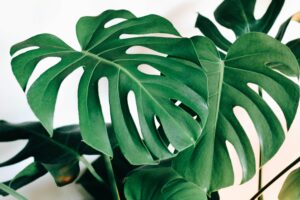
- Species: Monstera deliciosa
- Colors: Iconic split leaves in deep green hues
- Season: Thrives in all seasons
- Growth: Exhibits climbing tendencies, creating a bushy appearance
- Soil Composition: Flourishes in a well-aerated, peat-based mix
- Care: Enjoys bright indirect light, moderate watering, and periodic pruning.
3. Rubber Plant (Ficus Elastica):
Do you have the ideal houseplant? Something that grows for years, is simple to maintain, and is elegantly timeless? The rubber tree, in my opinion, checks all of those criteria. This tree looks great in any space thanks to its thick, glossy leaves.
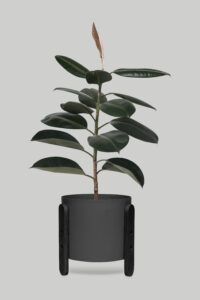
- Species: Ficus Elastica
- Colors: Dark green, glossy leaves with an elegant appearance
- Season: Adapts well to various seasons
- Growth: Grows tall, bringing an element of sophistication
- Soil Composition: Prefers well-draining soil
- Care: Flourishes in moderate to low light conditions and benefits from infrequent watering.
4. Bird of Paradise (Strelitzia Reginae):
When it comes to indoor plants, the Bird of Paradise rules top. This large, upright plant’s glossy, banana-shaped leaves fan out to give your area a rich, tropical flair. While it can tolerate a broad range of lighting conditions, including low, indirect light and direct sunlight, it is most resilient when placed in a sunny area.

- Species: Strelitzia Reginae
- Colors: Resembles banana leaves with shades of green
- Season: Flourishes in warmer months
- Growth: Towering and reminiscent of a tropical banana tree
- Soil Composition: Flourishes in well-draining soil with organic matter
- Care: Requires bright, indirect light and regular watering for optimal growth.
5. Alocasia Polly: Elephant Ear Plant
The thick leaves of this plant are almost as large as the ears of a newborn elephant. Although this plant requires little care, it might need to be pruned in the winter to get rid of crispy, browned leaves that have fallen or drooped.
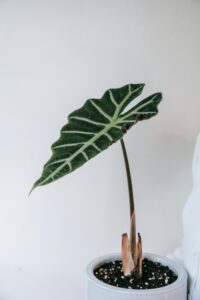
- Species: Alocasia Polly
- Colors: Dark green leaves with prominent veins
- Season: Prefers warmer seasons
- Growth: Compact and upright, making it suitable for smaller spaces
- Soil Composition: Flourishes in well-draining soil enriched with organic matter
- Care: Thrives in bright, indirect light and prefers consistently moist soil.
6. ZZ Plant (Zamioculcas Zamiifolia):
ZZ plants are a great option for beginners due to their hardiness and low maintenance requirements. Indoor gardening is an interesting effort to start on.
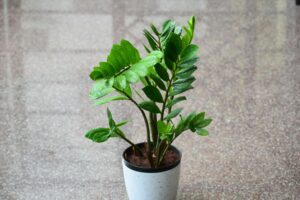
- Species: Zamioculcas Zamiifolia
- Colors: Dark green, glossy foliage providing an exotic touch
- Season: Thrives year-round
- Growth: Compact and bushy, making it an ideal low-maintenance choice
- Soil Composition: Flourishes in well-draining, sandy soil
- Care: Adaptable to low to bright indirect light, and benefits from infrequent watering.
7. Dieffenbachia (Dieffenbachia spp.):
Dieffenbachia plants are popular indoor houseplants because of their big, variegated leaves that can endure partial shade. In the winter, they want intense light, but in the growing period, they do not require direct sunlight—just sufficient light to keep them healthy.

- Species: Various Dieffenbachia species
- Colors: Variegated patterns of green and cream, adding a touch of elegance
- Season: Flourishes throughout the year
- Growth: Bushy with large, broad leaves for a tropical ambiance
- Soil Composition: Flourishes in well-draining, fertile soil
- Care: Moderate light, consistent moisture, and occasional pruning for optimal health.
8. Philodendron Selloum: (Philodendron Bipinnatifidum)
This kind of philodendron is small yet broad, and it grows rapidly and readily with minimal care, so it’s ideal for transforming that blank area in the living area of your home.
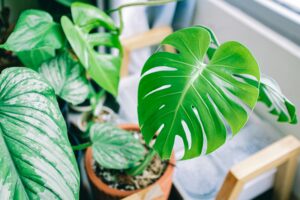
- Species: Philodendron Bipinnatifidum
- Colors: Deep green, deeply lobed leaves providing a tropical vibe
- Season: Adapts well to all seasons
- Growth: Bushy and tropical, creating a captivating visual appeal
- Soil Composition: Flourishes in well-draining, peat-based mix
- Care: Indirect light, consistently moist soil, and periodic pruning for optimal growth.
9. Calathea Medallion (Calathea Roseopicta):
The stunning calathea plant, with green stripes on top, embodies the greatest qualities of a houseplant: low light requirements and ease of upkeep. Since its leaves move in rhythm with the sun’s rising and setting, this plant is also regarded as a form of prayer plant.
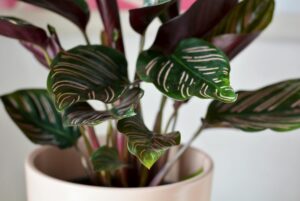
- Species: Calathea Roseopicta
- Colors: Patterned leaves with shades of green and purple, showcasing intricate beauty
- Season: Flourishes in warmer months
- Growth: Compact with round leaves for a unique appearance
- Soil Composition: Flourishes in well-draining soil enriched with organic matter
- Care: Indirect light, humidity maintenance, and consistent moisture for optimal health.
10. Peace Lily (Spathiphyllum spp.):
Peace lilies are a traditional house plant since they require strong light for growth, but they are also very low maintenance and easygoing. They can reach a maximum of six feet in height under ideal circumstances. Keep one of these away from cats as lilies pose a particular risk to them. Yours will do well if you plant it in a self-watering container.
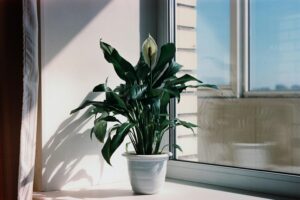
- Species: Various Spathiphyllum species
- Colors: Glossy green leaves complemented by elegant white flowers
- Season: Prefers warmer seasons
- Growth: Compact with graceful white blooms, adding a touch of serenity
- Soil Composition: Flourishes in well-draining, fertile mix
- Care: Indirect light, consistently moist soil, and occasional pruning for optimal growth.
11. Bamboo Palm (Chamaedorea Seifrizii):
Consider cultivating a bamboo palm to add a touch of the exotic to your living space. Although it is not part of the same genus, the bamboo palm plant was given its name due to its resemblance to bamboo. One excellent technique for imitating the appearance of a palm tree without sacrificing size or light requirements is to grow a bamboo palm tree.
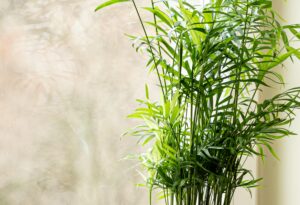
- Species: Chamaedorea Seifrizii
- Colors: Feathery, arching green fronds creating a tropical ambiance
- Season: Adapts well to all seasons
- Growth: Graceful and clumping, ideal for adding a touch of nature to any space
- Soil Composition: Flourishes in well-draining, rich soil
- Care: Bright, indirect light and regular watering for optimal health.
12.Spider Plant (Chlorophytum comosum):
Chlorophytum comosum, or spider plant, is regarded as one of the most versatile houseplants. Spider plants are among the easiest plants to maintain; these lovely green perennials are cultivated outside in warm climates and are also popular indoors as hanging basket plants around the country.
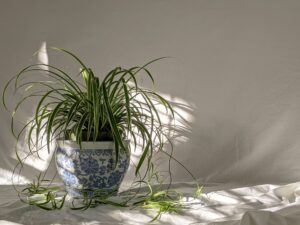
- Species: Chlorophytum comosum
- Colors: Arching green and white striped leaves, providing a cascading effect
- Season: Thrives year-round
- Growth: Cascading with baby Spiderettes, creating a dynamic appearance
- Soil Composition: Flourishes in well-draining potting mix
- Care: Indirect light, allowing the soil to dry between waterings for optimal health.
13. Schefflera (Schefflera Actinophylla):
Although these plants can produce blooms, indoor plants seldom do so. Schefflera prefers indirect, filtered light, vibrant, sandy soil that drains well, and temperatures that are continuously higher than 60°F. The schefflera plant is harmful to dogs and cats and slightly toxic to humans in all parts.

- Species: Schefflera Actinophylla
- Colors: Dark green, palmate leaves creating an umbrella-like appearance
- Season: Flourishes in warmer months
- Growth: Tall and umbrella-like, making it a captivating centerpiece
- Soil Composition: Flourishes in well-draining, loamy soil
- Care: Bright, indirect light and moderate watering for optimal growth.
14 .Croton (Codiaeum variegatum):
No, it’s not a common garden item on Mars. Though its name suggests something from a space opera, the croton plant, or Codiaeum Variegatum, is an annual evergreen species that is indigenous to Malaysia and India. Given that the croton seed resembles a tick in shape, the word “croton” is derived from the Greek word for tick. The firm, rubbery leaves of this tropical plant come in a variety of sizes, shapes, and colors. The plant’s hue may become almost entirely black as it ages.
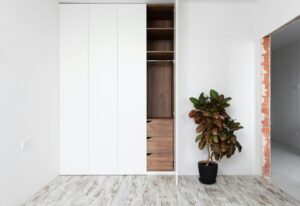
- Species: Codiaeum variegatum
- Colors: Variegated leaves in bold red, orange, and yellow, adding a burst of color
- Season: Prefers warmer seasons
- Growth: Upright with colorful foliage, creating a vibrant atmosphere
- Soil Composition: Flourishes in well-draining, sandy soil
- Care: Bright, indirect light and consistently moist soil for optimal health.
15. Nerve Plant (Fittonia spp.):
Fittonia is sometimes referred to as the net plant, mosaic plant, or nerve plant. She is possibly the most adorable small drama diva you have ever laid eyes on. Your fittonia will start to shrivel like a coffee junkie on a dose of caffeine fast if you neglect to water it often. We wouldn’t, however, go as far as to claim that fittonias would be on our list of species that require constant moisture. Put another way, compared to, say, an easy to maintain snake plant, this houseplant needs a little more attention.
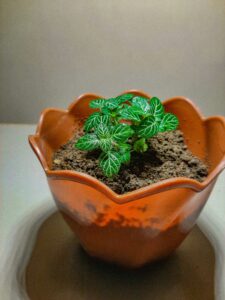
- Species: Various Fittonia species
- Colors: Vibrant green leaves with intricate veins, showcasing delicate beauty
- Season: Thrives year-round
- Growth: Low, spreading habit, making it an excellent ground cover
- Soil Composition: Flourishes in well-draining, peat-based mix
- Care: Indirect light, high humidity, and consistent moisture for optimal health.
As we conclude our exploration, these 15 big leaf indoor plants stand as testament to the diversity and beauty nature offers. Whether you’re drawn to the towering elegance of the Bird of Paradise or the intricate patterns of the Calathea Medallion, each plant brings a unique personality to your indoor oasis. Embrace the greenery, follow the care guidelines, and witness your indoor space transform into a haven of natural splendor.
Frequently Asked Questions (FAQ):
Q1: Why should I choose big leaf indoor plants for my home?
A1: Big leaf indoor plants not only add a touch of nature to your living space but also create a visually stunning and vibrant atmosphere. Their lush foliage can enhance the aesthetics of any room, making it more inviting and refreshing.
Q2: Are these big leaf plants suitable for beginners in indoor gardening?
A2: Absolutely! Many of the plants mentioned, such as the ZZ Plant, Snake Plant, and Peace Lily, are known for their low-maintenance nature. They tolerate a variety of conditions and are resilient, making them ideal for those new to indoor gardening.
Q3: Can these plants thrive in low-light conditions?
A3: Yes, several of the mentioned plants, including the ZZ Plant, Snake Plant, and Dieffenbachia, are well-suited for low-light environments. However, it’s essential to provide them with some indirect light to ensure healthy growth.
Q4: How often should I water these big leaf indoor plants?
A4: The watering frequency varies among the plants. Generally, it’s advisable to let the top inch of soil dry before watering. Plants like the Peace Lily and Alocasia Polly prefer consistently moist soil, while others, like the ZZ Plant and Snake Plant, can tolerate drier conditions.
Q5: Can I keep these big leaf plants in a small apartment or limited space?
A5: Absolutely! Many of the plants listed, such as the Alocasia Polly, Spider Plant, and ZZ Plant, have a compact growth habit, making them suitable for smaller living spaces. Consider the specific light and space requirements of each plant when arranging them in your home.
